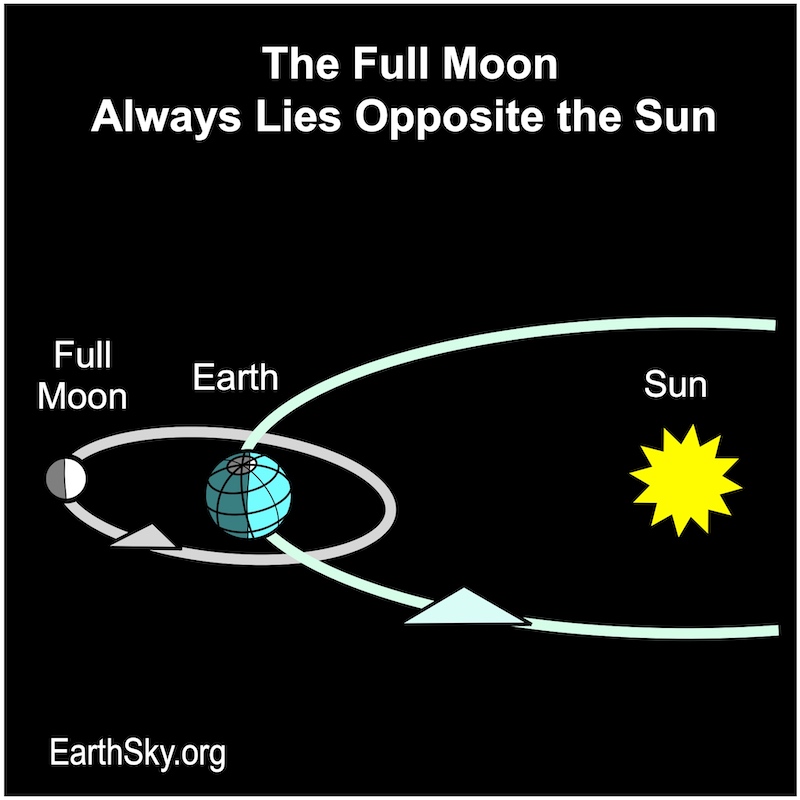The full moon on March 6-7, 2023, is the closest full moon to the equinox on March 20. It’ll lie close to the star Regulus within the constellation Leo.
March full moon
When to look at in 2023: Evening of March 6-7.
The place to look: Search for the intense spherical moon within the east within the night, overhead round midnight, and within the west earlier than dawn. It’s seen all night time.
Crest of the full moon falls at 12:40 UTC on March 7, 2023. That’s 6:40 a.m. CST in central North America. So should you reside in central North America, your fullest moon will come round daybreak on March 7, 2023.
It’s additionally the Worm Moon: All the complete moons have popular nicknames. Well-liked names for the March full moon are Worm Moon, Crow Moon and Sap Moon. The identify Worm Moon honors the stirring of earthworms and bug larvae within the slowly warming late winter and early spring soil.
Notice: The moon will look full and spherical for a day or two round full moon. That is the closest full moon to the March equinox.

Last chance to get a moon phase calendar! Only a few left.
Reverse a Harvest Moon
The March 6-7 full moon is the closest full moon to 2023’s March equinox, which can fall at 21:24 UTC on March 20.
It’s the spring equinox for the Northern Hemisphere. And it’s the autumn equinox for the Southern Hemisphere. So for us within the Northern Hemisphere, the March full moon reveals traits reverse these of a Harvest Moon. In the meantime, within the Southern Hemisphere, this full moon has all of the Harvest Moon traits.
Read: Full moon names by month and by season
What are the Harvest Moon’s traits?
We within the Northern Hemisphere have a practice of full moon names. We use the time period Harvest Moon for the full moon nearest the autumn equinox, in September or October.
And lots of the full moons do have distinctive, seasonal traits. For instance, all full moons rise at or round sundown. And – as a result of the moon strikes eastward in orbit – the moon sometimes rises about 50 minutes later with every passing day. However, across the time of the Harvest Moon, there’s solely a brief lag time between successive moonrises. The lag time between successive moonrises reaches a yearly minimal. As an illustration, at and round 40 degrees south latitude – across the time of the March full moon – the moon rises solely about 30 to 35 minutes later each day.
The brief time between successive moonrises continues for a number of days. So – across the time of the autumn equinox, and the Harvest Moon – there’s a vivid full-looking moon within the early night sky for a number of evenings in a row.
And that’s a Harvest Moon.
March full moon traits
Within the Northern Hemisphere, in a few years, the March full moon is the closest full moon to our spring equinox. So the lag time between successive moonrises reaches a yearly most. In different phrases, there’s an particularly very long time between moonrises, from one night time to the subsequent, across the time of the March full moon.
As an illustration, at 40 degrees north latitude, the moon rises some 75 minutes later from one night time to the subsequent, across the time of the March full moon. The longer-than-usual time between successive moonrises continues for a number of days. So – across the time of the spring equinox and the March full moon – there’s a longer-than-usual interval of darkness (no moon) in early night, for a number of days in a row following the date of full moon.
Arc of March full moon
And it’s not simply moonrise occasions. It’s additionally the peak of the moon’s arc throughout our sky that varies from month to month, and season to season. Each full moon rises within the east, because the sun units within the west. Each full moon arcs throughout the sky all through the night time, and units round daybreak. For us within the Northern Hemisphere, the arc of this March full moon is decrease than the paths of the complete moons of December, January and February.
For these within the Southern Hemisphere, the full moon’s arc throughout the sky is climbing increased with every successive month. After which, it’ll proceed to take action till across the June solstice.
Earlier than the appearance of synthetic lighting, our ancestors should have been nicely conscious of those seasonal vagaries of our wayward moon.
March full moon in Leo
The full moon on the night time of March 6-7, 2023, is situated within the route of the constellation Leo. It glows close to Leo’s brightest star, Regulus – mentioned to characterize the Coronary heart of the Lion – and the star Denebola, within the Tail of the Lion. Denebola is the western member of the asterism known as the Spring Triangle.
March full moons and Easter
The March full moon typically units the date of Easter Sunday, however not in 2023. In 2023, we’ve got a full moon in early March, and one other full moon in early April. Easter comes on the primary Sunday following the full moon after the March equinox. So the April full moon – on the night time of April 5-6, 2023 – units the date of Easter Sunday (April 9, 2023).
Read: When is Easter? And how is Easter tied to the night sky?

Backside line: The 2023 March full moon is close to two vivid stars in Leo the Lion on the night time of March 6-7.



